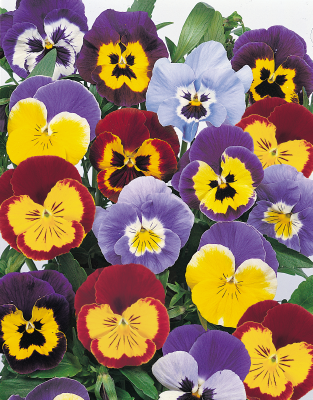
Joker® Mix
Item no.: VW6099R- Hardy pansy for fall and spring production
- Crop Time
- Spring: 25 - 27 weeks
- Height ∅
- 5 ″ / 13 cm
- Exposure
- Sun - Partial shade
- Seed Form
- Raw Seed
- Best Uses
- Bedding, Landscape
Culture guide
Usage
Plants for landscape and rock garden, pot plants, window boxes, plants for planting in bowls, bedding
Sow time
According to geographical location an light intensity (north earlier, south later) the sowing time varies around at approx. 20 days; Early-Mid July for flowering pots in autumn; Indoor forcing (frost free): End August- Mid September for flowering from spring onwards; Indoor forcing (with frost): Early August-Early September for flowering from spring onwards
Sowing method
1-3 seeds per plug or peat pot Sowing directly into field
Germination
4-7 days at 62-68 °F (15-18 °C). Cover seeds lightly with vermiculite. Do not keep too wet. Stage II (5-8 days) maintain temperatures of 62-68 °F (15-18 °C). Stage III and IV (4-5 weeks), 55-62 °F (13-16 °C), 100 ppm N weekly alternating 20-10-20 and 14-0-14.
Growing on
Transplant after 6- 7 weeks into packs or pots and grow on at 50-55 °F (10-13 °C). Fertilize weekly with 100-150 ppm N using 14-0-14 to promote root growth and compact habit. Supplement with calcium nitrate and potassium with magnesium, boron and other micro nutrients.
Media
Use a peat pot: 1,5 kg/m³ complete balanced fertilizer, 0-2 kg/m³ slow release fertilizer (3-6 months), iron-chelate, micronutrients, pH: 5.5-6.2. Field: humus sandy soils with good drainage. Standard fertilization: 40-60 g/m² of a slow release fertilizer.
Temperature
Peat pot: In winter protect the plants, if the plants are frozen, by shading against sun light and drying out.
Fertilization
Peat pot: Low fertilization levels are required. Fertilize the crop weekly with 100 ppm nitrogen (at 0 kg/m³ slow release fertilizer in substrate), using a potassium balanced fertilizer (N: K₂O-ratio: 1:1,5). The plants take up the minerals at 5 °C. Avoid high ammonium and high nitrogen levels. Fertilize in autumn and in winter with each irrigation (approx. 2-4 per months). In spring fertilize 100 ppm nitrogen of a potassium balanced fertilizer. Prevent magnesium deficiency by applying magnesium sulphate (0,025 %) 1-2 times and in case of Iron deficiency apply iron-chelate for 1-2 times. Temperatures below 10 °C will inhibit the iron uptake. Therefore take care of, that for iron fertilization the temperature is above 10 °C. Avoid nutrition deficiency in spring, because this a cause for high quantities of yellow leaves and very poor plant qualities. The roots are sensitive to high salt levels in substrates. Avoid high fertilizer concentrations, it is advisable to fertilize several times with low concentrations weekly. Take into consideration that outdoors nutrition might be washed out due to rainfall. Field: If necessary according to analysis, improve the soil with 40-60 g/m² of a slow release fertilizer, applied in several portions. Take care of iron supply.
Stage I Starts with the radicle breaking through the testa. The roots are touching the medium. Ends with fully developed cotyledons.
Stage II Starts from fully developed cotyledons. Ends with the fully developed true leaf or true leaf pair.
Stage III Starts from the fully developed true leaf or true leaf pair and ends with 80% of the young plants being marketable.
Stage IV All young plants are ready for sale and in the process of being hardened off. This stage lasts about 7 days.
The cultural recommendations are based on results from trials conducted under Central European conditions. Different conditions in other parts of the world may lead to deviations in results achieved.





